魚介類は保存しておくと良いでしょう。 ドライアイスペレット または ドライアイスブロック。夏は魚介類は保存が難しく、臭みが発生しやすくなります。しかし、魚介類は夏の代表的な高級食材の一つであり、新鮮な魚介類を食べるために氷を使うなど、さまざまな保存方法が試みられてきました。

しかし、夏が暑い場合、これらの魚介類の保存方法はあまり効果がありません。最近、ホテルでドライアイスシーフードを食べたときに、固体二酸化炭素ドライアイスを使ってシーフードを保存する良い方法を学びました。私も試してみましたが、魚介類を長期保存できました。お勧めする価値があります。
生きた魚介類を固体ドライアイスで保存する方法 ブロックまたはドライアイスペレット?
魚介類は通気性のある発泡インキュベーターに保管する必要があります。 ドライアイス スタックに保存する必要があります。まず、レイヤーを置きます ドライアイス顆粒 フォームボックスにドライアイスブロックを入れ、その上に干し草の層、または通気性の良い綿やスポンジを置き、その上にカニやその他の魚介類を置きます。魚介類を長持ちさせるには、ドライアイスとカニを重ねて入れる必要があります。


魚介類の保存には適切な温度が必要です。生きた魚介類を保存するには、水産物に快適な環境を提供する必要があります。温度が適切な場合に限り、魚介類はすぐには死なず、冷たすぎても熱すぎてもよくありません。通常、温度は魚介類の種類ごとに特性に応じて決定されます。したがって、 ドライアイス製品 生きた魚介類に直接触れることはできません。 ドライアイスの温度 極端に低いと魚介類は凍って死んでしまいます。
なぜドライアイスなのか ブロック 魚介類の保存に使用できます?


ドライアイスが新鮮な魚介類を保存できる理由は、その温度がマイナス78度に達することもあり、環境に優しく、汚染がなく、輸送や使用に便利であるためです。また、固体のドライアイスは揮発して炭酸ガスとなり、酸素を遮断して腐食を防ぐ働きがあります。
炭酸ガスは空気よりも比重が大きく、魚介類の表面を覆って酸素バリアの役割を果たし、魚介類の酸化速度を低下させ、細菌の増殖や増殖を抑制することができるというドライアイス特有の利点があります。食品や魚介類の保存。